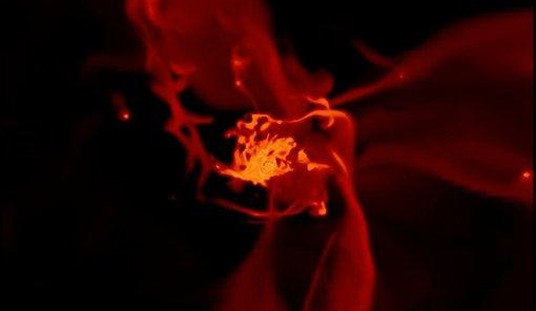You’ve seen the “Pillars of Creation” before. The iconic photo was first snapped by the Hubble Space Telescope in 1995, and again in 2014. Here are the 2014 and 1995 iterations of the iconic shot.

Beautiful, to be sure. But here’s the same shot taken by the gigantic James Webb Space Telescope.
Behold…the Pillars of Creation!
Using @NASAWebb's NIRCam, we're able to see this iconic star-forming region in a new way. See those wavy lines that look like lava at the edges of the pillars? These are baby stars that are forming within the gas & dust: https://t.co/CGaIpmAROf pic.twitter.com/6BbW9wBHsk— Thomas Zurbuchen (@Dr_ThomasZ) October 19, 2022
The detail is exquisite. “Along the edges of the pillars are wavy lines that look like lava. These are ejections from stars that are still forming. Young stars periodically shoot out jets that can interact within clouds of material, like these thick pillars of gas and dust,” according to a news release from the European Space Agency, one of the operators of the JWST.
Webb is operated by NASA, ESA and the Canadian Space Agency. The $10 billion space observatory, launched last December, has enough fuel to continue snapping unprecedented images of the cosmos for about 20 years.
Compared with the capabilities of other telescopes, the space observatory’s powerful, massive mirror and infrared light technology can uncover faint, distant galaxies that are otherwise invisible — and Webb has the potential to enhance our understanding of the origins of the universe.
Some of Webb’s first images, which have been rolling out since July, have highlighted the observatory’s capabilities to reveal previously unseen aspects of the cosmos, like star birth shrouded in dust.
However, astronomers are also using the telescope’s stable and precise image quality to illuminate our own solar system, and so far it has taken images of Mars, Jupiter and Neptune.
Yes, these are very pretty pictures and make for good computer wallpaper. But $10 billion?
Even space scientists were bitching about the cost. Think of what other NASA projects were left on the table because Webb sucked up so many tax dollars. There are at least a dozen missions of around a billion dollars each that might have been funded without the Webb. Missions to Mars, the Sun, an ambitious mission to check for life on Jupiter’s ice moon Europa, and mining an asteroid, to name a few.
It’s absolutely correct to criticize spending this money on Webb. It could be spent on better things, or that $10 billion could have been given back to the taxpayers as a tax cut. There is no rational, logical argument to be made that can justify the expenditure.
There is, however, an irrational and illogical argument: you cannot put a price tag on gathering knowledge of the universe or enhancing mankind’s joy of simply knowing.
There is no monetary value or reward for figuring stuff out — even complicated stuff like the origin of the universe and mankind’s place in the cosmos. The value comes from the sheer joy of feeding the insatiable curiosity that has cursed and blessed our species since we stood upright and began to think.
Unfortunately, unraveling these mysteries aren’t cheap. Gone are the days when great leaps forward in physics, astronomy, and cosmology were realized by earth-bound scientists with the help of a few graduate assistants. “No bucks, no Buck Rogers,” was heard often around NASA in the late 1950s and early ’60s. The recognition that only taxpayers could fund these giant robots we were sending into space changed the nature of science forever.
Earth-based observations take us only so far. The Webb Telescope allows us to do science as it has never been done before, to see and study the universe in ways unfathomable a generation ago. It’s an exciting time to be alive. And Webb promises to continue to shock and awe us with new discoveries.










Join the conversation as a VIP Member